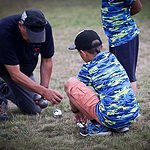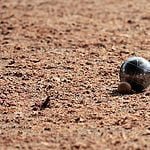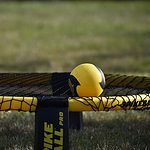When it comes to bocce ball, the size of the court is crucial for a fair and competitive game.
Have you ever wondered just how big a bocce ball court should be?
The dimensions play a significant role in gameplay, ensuring that players have enough space to strategize and aim for victory.
Let's explore the ideal size for a bocce ball court and how it can impact the overall experience of the game.
Key Takeaways
- Regulation bocce ball court size: 91 ft length, 13 ft width
- Importance of proper dimensions for fair and challenging gameplay
- Strategic shot placement due to width significance
- Clear boundaries and safety features ensure fair play
Dimensions of a Bocce Ball Court
A regulation bocce ball court typically measures 91 feet in length and 13 feet in width, providing a standardized playing area for the game. The court size is crucial in ensuring a fair and challenging bocce match. This specific dimension allows players to showcase their skills in precision and strategy while adhering to the official guidelines of the sport.
The court serves as the stage for bocce battles, where players aim to land their balls as close as possible to the pallino. With a 91 by 13 feet court, participants have ample space to strategize and execute their throws with finesse. The dimensions play a significant role in the game's dynamics, influencing how players approach each round and make decisions based on the court's size and layout.
Whether you're a seasoned bocce player or a newcomer to the game, understanding the importance of court size can enhance your overall bocce experience. Sharpen your skills, embrace the challenge, and enjoy the thrill of competing on a regulation-sized bocce court.
Length of a Bocce Ball Court
In standard bocce ball courts, the length typically ranges between 86.92 feet and 91 feet. Understanding the length of a bocce ball court is crucial for setting up a proper game environment.
Here are some key points to consider about the length of regulation bocce courts:
- Official Size: Regulation bocce ball courts measure 91 feet long, providing ample space for competitive play and adherence to standard dimensions.
- Backyard Courts: Backyard bocce ball courts can vary in length, usually around 60 feet, offering a more compact but still enjoyable playing area for casual games.
- Indoor Courts: Indoor bocce ball courts can be as small as 22 feet long, making them suitable for indoor recreational facilities or areas with limited space.
- Customization: Customizable court sizes allow for adaptation to available space, enabling players to create bocce ball courts that fit their specific needs and constraints.
Understanding the variety in court sizes helps players adapt to different playing environments and enjoy the game to its fullest.
Width of a Bocce Ball Court
Consider the official width of a bocce ball court to be 13.12 feet, a dimension critical for maintaining the integrity of gameplay and strategic shot placement. The 13.12 feet wide dimension ensures fair play and accuracy in bocce ball matches.
When setting up your court, this specific width is essential to guarantee that players have enough space to execute their shots effectively without feeling cramped. Additionally, the proper width allows for the placement of foul lines, which mark the boundaries within which players must stay during play. These foul lines not only keep the game organized but also add a layer of challenge as players strategically position their shots within the court.
Whether you're constructing a permanent bocce ball court or creating a makeshift one in your backyard, ensuring the width is 13.12 feet wide will contribute to the overall enjoyment and competitiveness of the game.
Bocce Ball Court Size Guidelines
To adhere to bocce ball court size guidelines, ensure the court is 91 feet long and 13 feet wide, with proper court markings and surface options tailored to enhance gameplay. When setting up a bocce ball court, here are some essential guidelines to keep in mind:
- Dimensions: A regulation bocce ball court should measure 91 feet in length and 13 feet in width to meet standard requirements.
- Court Markings: Include foul lines, mid court lines, and inbound markers to clearly define the playing area.
- Surface Options: Opt for a flat surface such as stone dust, clay, grass, or artificial turf to ensure consistent gameplay and smooth ball rolling.
- Backboards and Sideboards: Consider adding these features to the court for strategic play and to prevent balls from rolling out of bounds.
Official Bocce Ball Court Dimensions
For official bocce ball courts, the dimensions are set at 86.92 feet in length and 13.12 feet in width to ensure fair and consistent gameplay. These specific measurements are crucial for maintaining the integrity and standard of the game. On an official court, the single foul line is positioned 13 feet from the back wall, and the only marked line is the centerline, which divides the court into two equal halves. Below is a visual representation of the official bocce ball court dimensions:
| Aspect | Measurement |
|---|---|
| Length | 86.92 feet |
| Width | 13.12 feet |
| Foul Line Distance | 13 feet |
| Marked Line | Centerline |
These dimensions are carefully regulated to ensure that players have a consistent experience when playing on official bocce ball courts. While backyard bocce ball courts may vary in size, following these official measurements can help recreate the authentic bocce ball gameplay.
Casual Bocce Ball Court Measurements
Casual bocce ball courts typically vary in size, with dimensions commonly falling around 60 feet in length and 12 feet in width. Here are some key points to consider when setting up a casual bocce court:
- Design Features: Casual bocce courts often include pointing and shooting lines. Typically, there's a single line on each side situated 10 feet from the end line to help players with their throws.
- Acceptable Size: Smaller courts are acceptable for casual play as long as the center and foul lines are clearly marked. This flexibility allows for bocce enthusiasts to enjoy the game even with limited space available.
- Indoor Adaptation: Indoor bocce courts can be as compact as 22 by 6 feet, catering to indoor spaces where outdoor courts aren't feasible.
- Maintenance Tip: Regardless of the size of your bocce court, remember to check the levels periodically to ensure a fair and enjoyable playing surface. Keeping the court well-maintained contributes to the overall bocce experience.
Surface Options for Bocce Ball Courts
Surface options for bocce ball courts encompass a variety of materials, each offering distinct advantages and considerations for gameplay. Common surfaces used include clay, packed dirt, carpet, grass, and liquid surfaces. Court builders often recommend poured liquid surfaces for new courts to provide a smooth and fast-paced playing experience.
While there's no specific requirement for bocce ball court surfaces, the choice of material can significantly impact gameplay and maintenance. Clay courts are popular for their traditional feel, while packed dirt surfaces offer a more affordable option. Carpet surfaces are often chosen for indoor courts, providing consistency in play. Grass courts can be aesthetically pleasing but require regular maintenance to prevent weed growth. Liquid surfaces are gaining popularity due to their smoothness, but they may require more upkeep.
Consider the pros and cons of each surface material to determine the best option for your bocce ball court.
Backboard and Curbing for Bocce Courts
Considering the strategic elements and containment benefits, backboards and curbing are essential features of a well-designed bocce court. Here are some key points to keep in mind:
- Backboard: A backboard not only adds a strategic element to the game but also prevents bocce balls from rolling out of the court, ensuring a fair play environment.
- Curbing: Commonly made of concrete or weather-resistant wood, curbing around the court, usually at least six inches tall, helps contain the balls within the playing area and defines the court boundaries clearly.
- Bumper Boards: If using concrete curbing, bumper boards might be necessary for added ball protection and safety during intense gameplay.
- Water Drainage: Enclosed bocce courts should have proper water drainage systems in place, including weep holes, to prevent water accumulation, which could affect the quality and longevity of the court surface.
Space Requirements for a Bocce Court
When planning the construction of a bocce court, ensure the selected location allows for the official dimensions of 86.92 feet in length and 13.12 feet in width to accommodate proper gameplay. Official bocce courts provide ample space for players to enjoy the game comfortably.
While unofficial courts can be smaller based on yard space, it's important to have adequate room for players to move around freely. To prepare the court, skip lining the court can be done to create boundaries and define the playing area clearly. Additionally, covering the court with weed cloth before laying down the playing surface can help prevent weed growth and maintain the court's condition.
Choosing a spot with good drainage and minimal outdoor space interruption is crucial for optimal court construction. Consider underutilized spaces or areas that can be transformed to fit the dimensions of the bocce court, ensuring a suitable environment for gameplay.
Setting Up a Bocce Ball Court
To set up a bocce ball court properly, ensure the area is level, prepare three layers of materials, establish a drainage system, and construct a stable perimeter.
When building on a flat surface, follow these steps for a successful bocce ball court setup:
- Level Ground: Begin by choosing a flat area for the court to ensure an even playing surface.
- Three Layers: Layer the area with materials like crushed stone, oyster flour, and a final layer of finely crushed oyster shell to create a smooth and compact base.
- Drainage System: Incorporate a drainage system using perforated pipes to prevent water accumulation and maintain the court's integrity.
- Perimeter Construction: Build a stable perimeter using wood treated with deck sealant to prevent rot and ensure durability over time.





